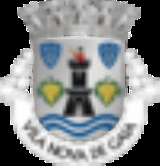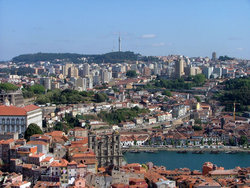
Vila Nova de Gaia
Encyclopedia

Vila Nova de Gaia Municipality
Vila Nova de Gaia Municipality is located in Porto District in Norte Region in Portugal. It contains the city of Vila Nova de Gaia.The municipality contains 24 parishes with a total population of 288,749 inhabitants, and is the most populous municipality in Norte Region.-Parishes:There are 24...
, Portugal
Portugal
Portugal , officially the Portuguese Republic is a country situated in southwestern Europe on the Iberian Peninsula. Portugal is the westernmost country of Europe, and is bordered by the Atlantic Ocean to the West and South and by Spain to the North and East. The Atlantic archipelagos of the...
. It is located in the Porto District
Porto District
The District of Porto , sometimes Oporto in English, is located on the north-west coast of Portugal. The district capital is the city of Porto, the second largest city in the country...
, south of the city of Porto
Porto
Porto , also known as Oporto in English, is the second largest city in Portugal and one of the major urban areas in the Iberian Peninsula. Its administrative limits include a population of 237,559 inhabitants distributed within 15 civil parishes...
on the other side of the Douro River. The city proper has a population of 178,255 and the municipality contains 24 parishes with a total population of 288,749 inhabitants, and is the most populous municipality in Norte Region. Gaia together with Porto and other 12 municipalities makes up the commonly designated Porto Metropolitan Area.
It is also well known for its "lodges" (locally known as "caves") where the world famous Port wine
Port wine
Port wine is a Portuguese fortified wine produced exclusively in the Douro Valley in the northern provinces of Portugal. It is typically a sweet, red wine, often served as a dessert wine, and comes in dry, semi-dry, and white varieties...
is stored and aged. The lodges have become a major tourist attraction.
Coat of arms and flag
The coat of armsCoat of arms
A coat of arms is a unique heraldic design on a shield or escutcheon or on a surcoat or tabard used to cover and protect armour and to identify the wearer. Thus the term is often stated as "coat-armour", because it was anciently displayed on the front of a coat of cloth...
consists of a grey crest with two golden-yellow bunches of grapes on the bottom with a black castle
Castle
A castle is a type of fortified structure built in Europe and the Middle East during the Middle Ages by European nobility. Scholars debate the scope of the word castle, but usually consider it to be the private fortified residence of a lord or noble...
over the water, and with a person blowing the horn.
The flag is colored dark yellow to black in four each.
History of the municipality
Vila Nova de Gaia already existed under the Roman EmpireRoman Empire
The Roman Empire was the post-Republican period of the ancient Roman civilization, characterised by an autocratic form of government and large territorial holdings in Europe and around the Mediterranean....
as the city of Cale
Portus Cale
Portus Cale was the old name of an ancient town and port in current day Portugal. It was located in the north of Portugal, in the area of today's Grande Porto.-Early History:...
. It developed most likely from a preexistent Celt
Celt
The Celts were a diverse group of tribal societies in Iron Age and Roman-era Europe who spoke Celtic languages.The earliest archaeological culture commonly accepted as Celtic, or rather Proto-Celtic, was the central European Hallstatt culture , named for the rich grave finds in Hallstatt, Austria....
ic Castro, or Neolithic settlement. The origin of the name Cale (or Gale, since in Classical Latin
Latin
Latin is an Italic language originally spoken in Latium and Ancient Rome. It, along with most European languages, is a descendant of the ancient Proto-Indo-European language. Although it is considered a dead language, a number of scholars and members of the Christian clergy speak it fluently, and...
there was not always a clear distinction between the letters "g" and "c") is likely Celtic
Celtic languages
The Celtic languages are descended from Proto-Celtic, or "Common Celtic"; a branch of the greater Indo-European language family...
, from the root "Gall-" with which Celts referred to themselves, similarly to Galicia, Gaul
Gaul
Gaul was a region of Western Europe during the Iron Age and Roman era, encompassing present day France, Luxembourg and Belgium, most of Switzerland, the western part of Northern Italy, as well as the parts of the Netherlands and Germany on the left bank of the Rhine. The Gauls were the speakers of...
or Galway
Galway
Galway or City of Galway is a city in County Galway, Republic of Ireland. It is the sixth largest and the fastest-growing city in Ireland. It is also the third largest city within the Republic and the only city in the Province of Connacht. Located on the west coast of Ireland, it sits on the...
. The river itself has a presumably Celtic name, Douro
Douro
The Douro or Duero is one of the major rivers of the Iberian Peninsula, flowing from its source near Duruelo de la Sierra in Soria Province across northern-central Spain and Portugal to its outlet at Porto...
(Durus in Latin) maybe after Celtic "dwr", water. In Roman times the bulk of the population probably lived south of the river Douro, and on the north side, there was a smaller settlement around the deep water port which now is the Ribeira
Ribeira
Ribeira is Portuguese and Galician for stream, ravine or rivulet, and may refer to:-Galicia:* Santa Uxía de Ribeira, a municipality, civil parish and town in A Coruña province-Portugal:...
neighbourhood of Porto
Porto
Porto , also known as Oporto in English, is the second largest city in Portugal and one of the major urban areas in the Iberian Peninsula. Its administrative limits include a population of 237,559 inhabitants distributed within 15 civil parishes...
. The name of Porto, in high medieval times Portus Cale
Portus Cale
Portus Cale was the old name of an ancient town and port in current day Portugal. It was located in the north of Portugal, in the area of today's Grande Porto.-Early History:...
, thus stood for the harbour ("portus" in Latin) of the city of Cale. With the important trade of the river Douro, which is easily navigable up to the Régua deep inland, the Porto part of the city came to overgrow Cale, and became the most important part of town, where the Bishopric and the merchants were established.
With the Moorish invasions in the eighth century C.E., the de facto frontier between the Islamic state and the Christian one came to rest for a considerable period of time on the river Douro, around the year 1000. With the constant raids and counter-raids, the town of Cale, or Gaia, was deserted and most of its inhabitants took refuge in Porto.
After the conquest and pacification of the southern side of the Douro river after 1035, with the exodus or expulsion of the Muslim populations, leaving behind semi-abandoned fertile lands, colonists from the north settled in exchange for better feudal contracts with the newly appointed lords. These migrants refounded the old city of Cale or Gaia under the name of Vila Nova de Gaia (new town of Gaia) around the old castle
Castle
A castle is a type of fortified structure built in Europe and the Middle East during the Middle Ages by European nobility. Scholars debate the scope of the word castle, but usually consider it to be the private fortified residence of a lord or noble...
and ruins of "old Gaia".
The name of the double city of Porto and Gaia was frequently referred to in contemporary documents as "villa de Portucale
Portucale
Portucale can mean different things:*Portus Cale, old Roman name of an ancient town and port in current day Portugal, in the area of today's Grande Porto...
", and the county of the Kingdom of León
Kingdom of León
The Kingdom of León was an independent kingdom situated in the northwest region of the Iberian Peninsula. It was founded in AD 910 when the Christian princes of Asturias along the northern coast of the peninsula shifted their capital from Oviedo to the city of León...
which was centered around it was named Condado Portucalense. This county was eventually expanded and after gaining its independence, became the Kingdom of Portugal
Portugal
Portugal , officially the Portuguese Republic is a country situated in southwestern Europe on the Iberian Peninsula. Portugal is the westernmost country of Europe, and is bordered by the Atlantic Ocean to the West and South and by Spain to the North and East. The Atlantic archipelagos of the...
.
Leisure
Vila Nova de Gaia is the Portuguese municipality with the biggest number of Blue Flag beachBlue Flag beach
The Blue Flag is a certification by the Foundation for Environmental Education that a beach or marina meets its stringent standards.The Blue Flag is a trademark owned by FEE which is a not-for-profit, non-governmental organisation consisting of 65 organisations in 60 member countries in Europe,...
es in 2009 and in 2010: 17 beaches along 17 km of seaside.


Miramar
Miramar is a place name of Spanish origin. It means "sea-view" or "sea sight" from mira and mar .-Places:Asia*Miramar, Panaji, GoaEurope*Miramar, a hamlet in the commune of Théoule-sur-Mer, France...
, Granja
Praia da Granja
Praia da Granja is located in the Northwest of Portugal, and belongs to the Vila Nova de Gaia municipality, Porto District.This place is also located in the town of São Félix da Marinha .-Name Origin:...
, Aguda
Aguda
Aguda is an African surname. People with this surname include:* Akinola Aguda , Nigerian jurist and former Chief Justice of BotswanaAguda is a Jurchen personal name...
, Valadares
Valadares (Vila Nova de Gaia)
Valadares is a Portuguese parish, located in the municipality of Vila Nova de Gaia. It has a population of 9,095 inhabitants and a total area of 4.94 km²....
, Francelos
Francelos
Francelos is a civil parish located in the municipality of Vila Nova de Gaia, Portugal....
, Madalena
Madalena, Vila Nova de Gaia
Madalena is a Portuguese parish in the municipality of Vila Nova de Gaia. It has a population of 9,356 and an area of 6.02 km²....
and Canidelo
Canidelo, Vila Nova de Gaia
Canidelo is a Portuguese parish in the municipality of Vila Nova de Gaia. It has a population of 23,737 and an area of 8.05 km².It is located along the mouth of Douro river and the Atlantic Ocean, across from Foz do Douro, Porto....
, Gaia.

